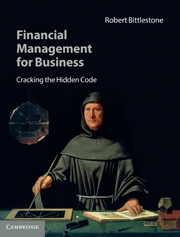Book contents
- Frontmatter
- Contents
- List of figures
- Introduction
- Acknowledgements
- Part 1 A dream of future wealth
- Part 2 The hidden art of management
- 13 The sweet spot
- 14 Elastic bands
- 15 An offer you can't refuse
- 16 The best of both worlds
- 17 Financial Perestroika on Interstate 95
- 18 Loads of money
- 19 Checkmate
- 20 Acts of God
- 21 Acts of men
- 22 Hubble, bubble, double-entry trouble
- 23 Credit crunch conclusion
- 24 Twenty-first-century accounting
- Appendix 1 Mathematical anchor
- Appendix 2 Getting to grips with cash
- Postscript
- Bibliography
- Index
24 - Twenty-first-century accounting
from Part 2 - The hidden art of management
Published online by Cambridge University Press: 05 June 2014
- Frontmatter
- Contents
- List of figures
- Introduction
- Acknowledgements
- Part 1 A dream of future wealth
- Part 2 The hidden art of management
- 13 The sweet spot
- 14 Elastic bands
- 15 An offer you can't refuse
- 16 The best of both worlds
- 17 Financial Perestroika on Interstate 95
- 18 Loads of money
- 19 Checkmate
- 20 Acts of God
- 21 Acts of men
- 22 Hubble, bubble, double-entry trouble
- 23 Credit crunch conclusion
- 24 Twenty-first-century accounting
- Appendix 1 Mathematical anchor
- Appendix 2 Getting to grips with cash
- Postscript
- Bibliography
- Index
Summary
If double-entry bookkeeping is defined as entering each transaction twice in one record, then … the primacy of medieval Italy in the development of the double-entry account is thus apparently assured. But if it is defined more broadly as entering each transaction twice at a time, albeit in two different records, then there is ample evidence for the practice in the detailed documentation from Drehem, ancient Puzrish-Dagan, the great cattle-yards constructed by King Shulgi of Ur (c. 2093–2046 BCE) in the 38th year of his reign (c. 2056 BCE) to service the religious capital of his realm at nearby Nippur as well as the political capital at more distant Ur.
W. W. HalloIf you are currently studying for your financial management examinations then you may feel somewhat cheated by the title of this final chapter, because my reference is to the twenty-first century BC rather than AD. But I make no apology for this mild deception because I think it is a salutory lesson for us all to appreciate that sophisticated financial frameworks have been an integral part of civilisation for several thousand years. The application of computer-based visualisation provided via this book and the website is therefore a new development focusing on a very old problem, and it will provide us with both perspective and contrast if we consider a few examples.
Here is an extract from a British Museum colloquium held in the year 2000 (AD), devoted to the financial practices of ancient civilisations.
- Type
- Chapter
- Information
- Financial Management for BusinessCracking the Hidden Code, pp. 173 - 176Publisher: Cambridge University PressPrint publication year: 2010



